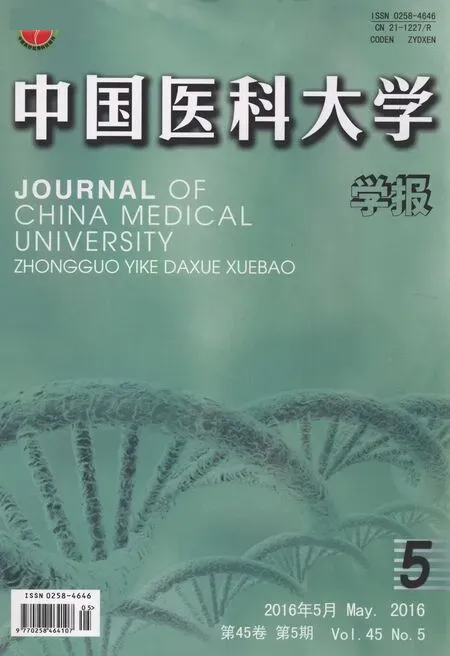18F-FDG PET/CT显像对胃肠肿瘤术后肠梗阻病因学的诊断价值
2016-09-05李雪娜杜补林李亚明
李雪娜,李 娜,杜补林,李亚明
(中国医科大学附属第一医院核医学科,沈阳110001)
18F-FDG PET/CT显像对胃肠肿瘤术后肠梗阻病因学的诊断价值
李雪娜,李娜,杜补林,李亚明
(中国医科大学附属第一医院核医学科,沈阳110001)
目的探讨氟-代脱氧葡萄糖正电子发射型断层显像(18F-FDG PET/CT)显像对胃肠肿瘤术后肠梗阻病因学的诊断价值。方法胃肠肿瘤术后不明原因肠梗阻行18F-FDG PET/CT显像的患者51例,图像分析采用视觉定性和通过半定量分析测量病变最大标准摄取值(SUVmax)。所有患者经手术病理学诊断或临床≥6个月以上的随访。计算18F-FDG PET/CT显像诊断胃肠肿瘤术后肠梗阻病因的敏感度、特异度和准确性。结果51例患者中,35例患者最终诊断为恶性肿瘤复发性肠梗阻,16例为非复发性肠梗阻。18F-FDG PET/CT显像阳性36例,其中33例患者最终诊断为恶性肿瘤复发性肠梗阻,3例显像假阳性为腹膜炎粘连性肠梗阻、吻合口炎症。2例18F-FDG PET/CT显像假阴性为腹膜微浸润。恶性肿瘤复发性肠梗阻病变的SUVmax为8.86±4.82,非复发性肠梗阻病变的SUVmax为2.05±1.95,两者差异有统计学意义(t=7.15,P<0.01)。18F-FDG PET显像诊断恶性肿瘤复发性肠梗阻的敏感度为94.3%,特异度为81.3%,准确性为90.2%。结论恶性肿瘤复发性肠梗阻的18F-FDG摄取率明显高于非复发性肠梗阻,18F-FDG PET/CT显像对肠梗阻病因学有很好的诊断价值。
肠梗阻;正电子发射断层显像术;X线计算机体层摄影术
网络出版地址
肠梗阻是胃肠肿瘤术后常见的急腹症,胃肠肿瘤术后肠梗阻的原因主要分为肿瘤复发或非肿瘤因素引起的肠梗阻。复发性肠梗阻严重影响肿瘤的预后,及时、准确的对肠梗阻的病因学进行诊断,是有效治疗的关键。目前,对于胃肠道肿瘤术后的患者,由于手术后正常的解剖发生了变化,传统的影像学在术后瘢痕、炎性和肿瘤复发诊断方面具有局限性[1]。氟-代脱氧葡萄糖正电子发射型断层显像(18fluorodeoxyglucose positron emission tomography,18F-FDG PET/CT)通过探测恶性细胞的糖代谢,利用增高的改变来提供代谢的信息,在胃肠肿瘤术后复发的诊断中优于传统影像学[2-3],但在胃肠肿瘤术后肠梗阻的病因学诊断中的价值还不清楚。本研究通过回顾性分析51例胃肠肿瘤术后不明原因肠梗阻行18F-FDG PET/CT显像的患者,探讨18F-FDG PET/CT显像对胃肠肿瘤术后肠梗阻病因学的诊断价值。所有患者经手术病理学诊断且临床≥6个月的随访。
1 材料与方法
1.1一般资料
选择2005年1月至2014年12月于中国医科大学附属第一医院核医学科行18F-FDG PET/CT显像的胃肠肿瘤术后不明原因肠梗阻的患者。入选标准:(1)胃肠肿瘤手术史;(2)临床诊断肠梗阻;(3)近期未进行梗阻有创性诊断和治疗;(4)最终进行了病理学诊断或≥6个月的临床随访。符合入选标准的患者51例,其中男性34例,女性17例,平均年龄(64.76±13.34)岁。
1.2方法
1.2.1PET/CT显像:PET/CT显像采用美国GE Discovery LS PET/CT仪,层厚4.25 mm。18F-FDG由美国GE minitracer回旋加速器生产,通过合成模块自动合成,放化纯>95%。患者空腹4 h以上,空腹血糖<10 mmol/L。平静状态下按约5.55 MBq/kg通过静脉三通管注射18F-FDG。在暗室平卧50~60 min后行体部PET/CT显像,每个床位采集3 min,层厚5 mm。图像重建采用有序子集最大期望值迭代法,得到三维图像及横断、冠状、矢状断层图像。
1.2.2图像分析:所有患者的图像均在GE XELERIS图像处理工作站进行分析处理,经2位以上有腹部PET和CT诊断经验的医师逐层阅读PET/CT影像,在充分鉴别胃肠道生理性摄取的情况下,通过视觉分析局灶性18F-FDG分布明显高于周围肠道组织,即为高代谢病灶,PET显像为阳性表现。对于病灶或选择病灶摄取最显著的层面,应用感兴趣区技术测定病灶的最大标准摄取值(maximum standard uptake value,SUVmax)。
1.3统计学处理
采用SPSS 19.0统计软件。计量资料用x±s表示,均数比较采用t检验,率的比较采用χ2检验。P<0.05为差异有统计学意义。
2 结果
胃肠肿瘤术后的51例患者中,胃癌37例,结直肠癌14例。肠梗阻发生的平均术后时间为(3.05± 3.65)年。19例肠梗阻的性质经二次手术病理诊断,32例肠梗阻经临床随访诊断。最终35例患者诊断为恶性肿瘤复发性肠梗阻,所占比率为68.63%(35/ 51)。35例恶性肿瘤复发性肠梗阻中,胃肠肿瘤术后局部复发4例,腹腔内、腹膜、淋巴结转移31例。16例为非复发性肠梗阻,所占比率为31.37%(16/ 51)。16例非复发性肠梗阻中,腹膜炎粘连5例,吻合口炎症4例,肠管炎症7例。
18F-FDG PET/CT显像阳性者36例,发现高代谢病灶57个,高代谢病灶的部位分别为胃壁、肠壁、吻合口、腹膜、淋巴结。18F-FDG PET/CT显像阳性患者中,33例患者最终诊断为恶性肿瘤复发性肠梗阻,3例假阳性病例为腹膜炎粘连性肠梗阻、吻合口炎症。2例18F-FDG PET/CT显像假阴性为腹膜微浸润。恶性肿瘤复发性肠梗阻组病变的SUVmax为8.86±4.82,非复发性肠梗阻组病变的SUVmax为2.05± 1.95,2组差异有统计学意义(t=7.15,P<0.01)。典型18F-FDG PET/CT图像见图1、2。恶性肿瘤复发性肠梗阻组患者的年龄为(65.85±13.41)岁,非复发性肠梗阻组患者的年龄为(62.37±13.29)岁,2组间年龄无统计学差异(t=0.86,P>0.05)。恶性肿瘤复发性肠梗阻组中男性23例,女性12例,非复发性肠梗阻组中男性11例,女性5例,2组间性别无统计学差异(χ2=0.05,P>0.05)。18F-FDG PET显像诊断恶性肿瘤复发性肠梗阻的敏感度为94.3%,特异度为81.3%,准确性为90.2%,阳性预测值为91.6%,阴性预测值为86.7%。
3 讨论
胃肠道肿瘤是最常见的恶性肿瘤之一。手术治疗是胃肠道肿瘤有效、治愈率高的方法,但术后发生肠梗阻的并发症较高,是一个非常重要的临床问题。术后肠梗阻的发生与原发肿瘤的分期、手术方式、消化道的重建手术廓清范围等诸多因素相关。按其病因学可分为复发性肠梗阻和非复发性肠梗阻,两者的治疗和预后均有显著差异,恶性肿瘤复发性肠梗阻的预后明显不良[4]。因此,胃肠肿瘤术后肠梗阻的病因学诊断至关重要。腹部X线平片是临床怀疑肠梗阻患者的首选诊断方法,对肠梗阻的检出率较高,但由于腹部平片中腹部组织器官的重叠,分辨率低,因此病因学的诊断较低[5]。传统影像学在术后瘢痕、炎性和肿瘤复发方面具有局限性。18F-FDG PET/CT显像实现了功能代谢显像与解剖显像的同机融合,基于肿瘤细胞糖代谢增高的特性,肿瘤细胞能够摄取18F-FDG,而瘢痕组织无明显的18F-FDG增高[6],为胃肠肿瘤术后复发、转移的诊断提供了一种新的方法[7-9]。但18F-FDG PET/CT显像在胃肠肿瘤术后肠梗阻中病因学的应用价值尚未见报道。

图1 病例1的18F-FDG PET/CT图像Fig.118F-FDG PET/CT image of case 1

图2 病例2的18F-FDG PET/CT图像Fig.218F-FDG PET/CT image of case 2
本研究回顾性分析了胃肠肿瘤术后不明原因肠梗阻行18F-FDG PET/CT显像的患者,分析恶性肿瘤复发性肠梗阻和非复发性肠梗阻病变的糖代谢特点和18F-FDG PET/CT显像对肠梗阻病因学的诊断的效能。我们发现,复发性肠梗阻组病变18F-FDG摄取明显高于非复发性肠梗阻组,差异有统计学意义,提示引起胃肠肿瘤术后肠梗阻的恶性复发病变具有高糖代谢表现。Yang等[10]和Gade等[11]研究显示,胃癌、结肠癌术后的复发病变具有18F-FDG摄取增高的特点,与本研究结果一致,但这两项研究并未纳入胃肠肿瘤术后肠梗阻的病例。Wu等[12]的研究结果显示,18F-FDG PET/CT显像阳性组患者的1年生存率明显低于18F-FDG PET/CT显像阴性组,也提示病变18F-FDG摄取率增高与复发性肠梗阻具有相关性。Mori等[13]研究显示,结肠癌术前肠梗阻病变18F-FDG摄取增高。
本研究显示,18F-FDG PET显像诊断恶性复发性肠梗阻的敏感度为94.3%,特异度为81.3%,准确性为90.2%。本研究中18F-FDG PET显像诊断恶性复发性肠梗阻的特异度略低,因为本研究中3例炎性肠梗阻的18F-FDG PET显像呈阳性表现。尽管本研究结果显示恶性复发性肠梗阻组病变18F-FDG摄取明显高于非复发性肠梗阻,但复发性肠梗阻与炎性肠梗阻的18F-FDG摄取仍有所重叠。由于胃肠道属于功能性器官,因此胃肠道的蠕动等都会导致一定的18F-FDG背景摄取[14]。因此本研究中,18F-FDG PET显像阳性的诊断标准为在充分鉴别胃肠道生理性摄取的情况下,腹腔内见局限性18F-FDG摄取明显高于周围肠道组织,尽量降低18F-FDG PET显像的假阳性率。本研究中,PET显像3例假阳性病例为腹膜炎粘连性肠梗阻和吻合口炎症。Lee等[15]的研究显示,胃癌术后吻合口炎症具有18F-FDG摄取增高的表现。有研究[16]显示,结肠癌引起的阻塞性结肠炎18F-FDG增高。由于白细胞、中性粒细胞、巨噬细胞等炎性细胞也具有18F-FDG摄取的特性,因此炎症也可以有高糖代谢的表现。关于炎性肠梗阻18F-FDG PET显像鉴别的重点,一项病例报道显示延迟显像可降低18F-FDG PET显像的假阳性率[17]。本研究中,2例显像假阴性为腹膜微浸润。由于PET显像空间分辨率的原因,对于微小的腹膜转移摄取为阴性,因此提高PET显像的分辨率和结合临床资料综合诊断是降低假阴性的方向。本研究有一定的局限性,为回顾性研究,样本量较少,有待进行前瞻性研究、扩大样本量,进一步深入分析。
综上所述,恶性肿瘤复发性肠梗阻的18F-FDG摄取率明显高于非复发性肠梗阻,18F-FDG PET/CT显像对肠梗阻病因学的诊断有很好的诊断价值。
[1]Tuca A,Guell E,Martinez-Losada E,et al.Malignant bowel obstruction in advanced cancer patients:epidemiology,management,and factors influencing spontaneous resolution[J].Cancer Manag Res,2012,4(6):159-169.
[2]Lee JW,Jo K,Cho A,et al.Relationship between18F-FDG uptake on PET and recurrence patterns after curative surgical resection in patients with advanced gastric cancer[J].J Nucl Med,2015,56(10):1494-1500.
[3]Caglar M,Yener C,Karabulut E,et al.Value of CT,FDG PET-CT and serum tumor markers in staging recurrent colorectal cancer[J]. Int J Comput Assist Radiol Surg,2015,10(7):993-1002.
[4]Pameijer CR,Mahvi DM,Stewart JA,et al.Bowel obstruction in patients with metastatic cancer:does intervention influence outcome?[J].Int J Gastrointest Cancer,2005,35(2):127-133.
[5]周彤,伍晓汀,周业江,等.腹部X线、超声、CT检查对肠梗阻诊断的临床分析[J].实用临床医药杂志,2006,10(1):53-55.
[6]鲍俊初,周文兰,王全师,等.18F-FDG PET/CT显像在胃癌术后复发和转移中的诊断价值[J].中国临床医学影像杂志,2010,2l(10):701-704.
[7]Cayvarlı H,Bekiş R,Akman T,et al.The role of18F-FDG PET/CT in the evaluation of gastric cancer recurrence[J].Mol Imaging Radionucl Ther,2014,23(3):76-83.
[8]Zou H,Zhao Y.18FDG PET-CT for detecting gastric cancer recurrence after surgical resection:a meta-analysis[J].Surg Oncol,2013,22(3):162-166.
[9]Zhang Y,Feng B,Zhang GL,et al.Value of18F-FDG PET-CT in surveillance of postoperative colorectal cancer patients with various carcinoembryonic antigen concentrations[J].World J Gastroenterol,2014,20(21):6608-6614.
[10]Yang ZY,Hu SL,Shi W,et al.The clinical value of fluorine-18 fluorodeoxyglucose positron emission tomography/computed tomography in postoperative patients with gastrointestinal mucinous adenocarcinoma[J].Nucl Med Commun,2011,32(11):1018-1025.
[11]Gade M,Kubik M,Fisker RV,et al.Diagnostic value of18F-FDG PET/CT as first choice in the detection of recurrent colorectal cancer due to rising CEA[J].Cancer Imaging,2015,15(1):11.
[12]Wu WG,Dong P,Wu XS,et al.Surgical management of patients with bowel obstructions secondary to gastric cancer[J].World J Gastroenterol,2013,19(28):4559-4567.
[13]Mori S,Oguchi K.Application of18F-fluorodeoxyglucose positron emission tomography to detection of proximal lesions of obstructive colorectal cancer[J].Jpn J Radiol,2010,28(8):584-590.
[14]Esteves FP,Schuster DM,Halkar RK,et al.Gastrointestinal tract malignancies and positron emission tomography:an overview[J]. Semin Nucl Med,2006,36(2):169-181.
[15]Lee DY,Lee CH,Seo MJ,et al.Performance of18F-FDG PET/CT as a postoperative surveillance imaging modality for asymptomatic advanced gastric cancer patients[J].Ann Nucl Med,2014,28(8):789-795.
[16]Oh JK,Park HL,Park SY,et al.18F-FDG PET/CT findings of obstructive colitis proximal to colorectal cancer[J].Clin Nucl Med,2014,39(2):136-141.
[17]Zade A,Purandare N,Rangarajan V,et al.Role of delayed imaging to differentiate intense physiological18F-FDG uptake from peritoneal deposits in patients presenting with intestinal obstruction[J]. Clin Nucl Med,2012,37(8):783-785.
(编辑陈姜)
Clinical Significance of18F-FDGpET/CT in the Etiological Diagnosis of postoperative Intestinal Obstruction in patients with Gastrointestinal Cancer
LI Xuena,LI Na,DU Bulin,LI Yaming
(Department of Nuclear Medicine,The First Hospital,China Medical University,Shenyang 110001,China)
Objective To explore the significance of18fluorodeoxyglucose positron emission tomography(18F-FDGPET/CT)in the etiological diagnosis of postoperative intestinal obstruction in patients with gastrointestinal cancer.Methods A total of 51 patients with postoperative intestinal obstruction undergone18F-FDG PET/CT were enrolled for the study.The images were interpreted by visual and semi-quantitative analysis(maximum standard uptake value,SUVmax).All the cases were confirmed by pathology and clinical follow-up for more than half a year.The sensitivity,specificity and accuracy of18F-FDG PET/CT for detecting malignant intestinal obstruction were calculated.Results Of the 51 patients,35 cases were confirmed for malignant intestinal obstruction,and 16 cases were caused by other benign diseases.18F-FDG PET/CT imaging was positive in 36 cases,and 33 cases were diagnosed as malignant and recurrent intestinal obstruction.Three cases of PET false-positive were peritonitis adhesion and anastomotic inflammation.Two cases of PET false negative were peritoneal micrometastasis.The SUVmaxof malignant lesions was 8.86±4.82,and the SUVmaxof benign lesions was 2.05±1.95.The uptake of FDG was significantly higher in malignant intestinal obstruction than in benign intestinal obstruction(t=7.15,P<0.01).The sensitivity,specificity,and accuracy of18F-FDG PET/CT diagnosis of malignant lesion were 94.3%,81.3%,and 90.2%,respectively.Conclusion The uptake of18F-FDG in malignant intestinal obstruction was higher than that in benign intestinal obstruction.18F-FDG PET/CThave a good diagnostic value for the intestinal obstruction of postoperative gastrointestinal cancer.
intestinal obstruction;positron emission-tomography;X-ray computed tomography
R445.5
A
0258-4646(2016)05-0422-04
10.12007/j.issn.0258-4646.2016.05.010
国家自然科学基金(81301249);辽宁省科学技术计划(2012225013)
李雪娜(1980-),女,讲师,博士.
李亚明,E-mail:ymli2001@163.com
2016-01-13
网络出版时间:
